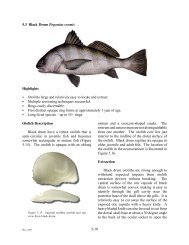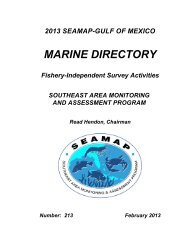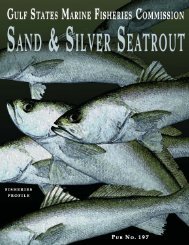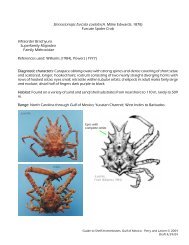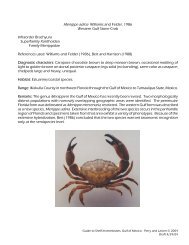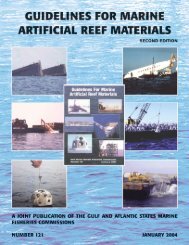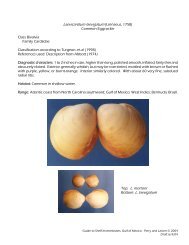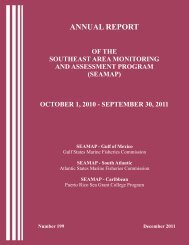Basic Commercial Fishing Regulations - Gulf States Marine ...
Basic Commercial Fishing Regulations - Gulf States Marine ...
Basic Commercial Fishing Regulations - Gulf States Marine ...
You also want an ePaper? Increase the reach of your titles
YUMPU automatically turns print PDFs into web optimized ePapers that Google loves.
General Information<br />
8<br />
Proper Care<br />
for your<br />
Catch<br />
Louisiana’s anglers are accustomed<br />
to abundant catches of bass,<br />
bream, sac-a-lait and various saltwater<br />
fish. A common problem, however,<br />
is improper handling of fish<br />
intended for the table.<br />
Quickly ice down fish. This<br />
sounds elementary, but there are those<br />
who get swept up in the thrill of<br />
catching fish and forget this important<br />
step. Fish should be placed on ice<br />
immediately upon being caught. Be<br />
sure you have ample ice before leaving<br />
the dock.<br />
Take full advantage of your ice.<br />
This means pouring the ice out of the<br />
bag and making sure there is a layer<br />
of ice above and below the fish.<br />
Fish placed in an ice/water slurry<br />
chill faster than those placed on ice<br />
alone. Leave water in your ice chest<br />
as long as an adequate amount of ice<br />
stays in the water. Water temperatures<br />
will stay at or near 32 degrees<br />
Fahrenheit and help keep fish cool.<br />
Another technique effective in<br />
keeping fish fresh on hot days or for<br />
extended periods is to gut the fish and<br />
pack the body cavities with ice. That<br />
chills the fish faster.<br />
Caution: It is illegal to fillet saltwater<br />
finfish before returning to the<br />
dock. This means that those with<br />
camps in the marshes and swamps<br />
must keep their fish intact, though<br />
gutting is allowed. For the purpose of<br />
consumption at sea aboard the harvesting<br />
vessel, a person shall have no<br />
more than two pounds of finfish parts<br />
per person on board the vessel, provided<br />
that the vessel is equipped to<br />
cook such finfish and such finfish<br />
does not exceed applicable bag limits.<br />
Bank and surf anglers often use<br />
stringers and live baskets to hold their<br />
catch. If using a stringer, put the<br />
stringer through the jaw tissue and<br />
not the gills.<br />
Those using baskets should be<br />
aware that overcrowded fish can easily<br />
die. Anglers with live wells on<br />
their boats also should be aware of<br />
this danger.<br />
A bit of attention to details will<br />
ensure that fish stay fresh longer and<br />
taste better when cooked. It may take<br />
a few more minutes, but the result<br />
will be a more enjoyable and memorable<br />
trip.<br />
Use these guidelines to measure a fish correctly (refer to illustrations):<br />
1. Place the fish on its side on a flat board with the jaw closed.<br />
2. Total length - Measure in a straight line from the tip of the<br />
snout to the extreme tip of the tail fin. Adjust the tail by rotating<br />
(Example 1) or by squeezing (Example 2) to obtain the maximum<br />
length of the fish. (illustration 1)<br />
3. Fork length - Measure in a straight line from the tip of the<br />
snout to the fork of the tail. (illustration 2)<br />
4. Lower jaw fork length - Measure in a straight-line length from<br />
the tip of the lower jaw to the fork of the tail. (illustration 3)<br />
5. Curved fork length - Measure from the tip of the upper jaw to<br />
fork of tail measured along the contour of the middle of the<br />
body. (illustration 4)<br />
6. Carcass length - Measure curve from posterior edge of gill<br />
opening to anterior portion of caudal keel. (illustration 4)<br />
illustration 1<br />
How to Measure a Fish<br />
58<br />
Example 1. Rotating.<br />
Example 2. Squeezing.




